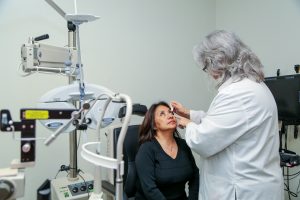
What is dry eye?
This condition—which affects more people now than ever before—is caused either by the eye not producing enough tears or tears evaporating too quickly. It can also be called keratoconjunctivitis sicca (KCS), dysfunctional tear syndrome, lacrimal keratoconjunctivitis, evaporative tear deficiency, aqueous tear deficiency and LASIK-induced neurotrophic epitheliopathy (LNE).
How common is it?
Approximately 5 million Americans have dry eye; 3 million of them are women.
Who is at risk for dry eye?
While anyone can be affected by dry eye, there are a number of risk factors.
Age: The elderly experience dry eye more frequently than other people.
Gender: Menopausal women over age 50 are the group most likely to have dry eye. Pregnant women are also susceptible to it.
Underlying Health Issues: Rheumatoid arthritis, thyroid disease, Sjögren’s syndrome and lupus can contribute to dry eye. Allergies can also trigger it in some people. The condition may be a side effect of certain medications, if you develop it, alert your eye care professional to all medications that you are taking.
Lifestyle: An increase in the use of smartphones, tablets and computers has lead to a rise in the number of younger people with the condition.
Is it serious?
While dry eye will likely not lead to permanent loss of vision, it can disrupt a number of daily activities for sufferers. Using a computer or reading for a long period of time may be difficult. It can also be uncomfortable for people with the condition to stay in dry environments, such as airplanes, for long periods of time. If left untreated, chronic dry eye may result in ulcers or scars on the cornea, as well as some loss of vision.
How can a lack of tears cause dry eyes?
Tears are critical for healthy eyes and clear vision. They nourish the cornea, the dome-shaped surface that covers the eye in front of the iris. The cornea helps the eye to focus, and also protects it from germs and dust. Without sufficient tears, the cornea can be susceptible to infection and unable to properly function. Tears also keep the surface of the eye moist and wash away debris and dust. They have an important role in protecting the eye from infections.
What are the symptoms of dry eye?
Suffers of dry eye may experience these symptoms:
- Eye fatigue
- The feeling that there is sand or dirt in the eye
- A stinging, burning or redness of the eye
- An abundance of tears after periods of the eye being dry
- Stringy discharge
- Blurred vision or discomfort when wearing contact lens or working on a computer or tablet
- The inability to cry
- Moments of blurred vision
How is dry eye diagnosed?
A comprehensive eye exam is necessary to properly diagnose the condition. It is recommended by the American Optometric Association that people under 65 have exams at least every two years, and annually for those who are older.
Can it be treated?
Yes, there are numerous treatment options for dry eye. If you suffer from any of the symptoms listed, see an optometrist for a proper diagnosis. If it is dry eye, they will first determine if it is caused by an underlying medical condition.
Many doctors will prescribe cyclosporine, an anti-inflammatory medication that reduces corneal damage while increasing tear production. An eye care professional may also recommend that you stop wearing contact lens and get tested for allergies.
Some people have dry eye because the drainage holes at the inner corners of the eyelids are unable to properly drain tears from the eyes to the nose. Closing the holes allows tears to remain on the eyes longer, reducing the change of extreme dryness. To do this, temporary plugs (made of silicone or collagen) are painlessly inserted into these drainage holes by an optometrist. Surgery may be recommended to permanently plug these holes.
What, if any, preventative measures can be taken?
There are a number of preventative steps that can be taken. Air cleaners can filter dust in indoor spaces that may exacerbate the condition. Humidifiers add moisture to the air. When it is necessary to use computers or watch screens for long periods of time, let eyes rest at different intervals throughout the activity.
To schedule a comprehensive eye exam at the University Eye Center, click here or call 📞 (888) 601-8811.
